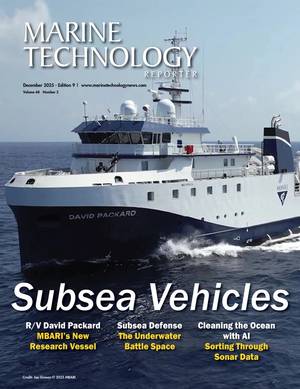-

A Graveyard for Glaciers
Last year, headstones carved from ice by Icelandic sculptor Ottó Magnússon were placed in a windswept field by the sea to create, before they melted away, a Glacier Graveyard. The headstones bore the names of glaciers from around the world that are lost or waning due to global warming.Among them were:• Pico Humboldt, the last of Venezuela's glaciers, now gone• Anderson Glacier, in Washington U.S., disappeared in 2011• Kilimanjaro…
-

The Future of Coral Reef Protection
The future of coral reef protection lies at the intersection of technology and collaboration, say Australian researchers who are designing a global real-time monitoring system.They hope to help save the world’s coral reefs from further decline, primarily caused by bleaching as a result of global warming. In the past two years, 75% of coral reefs worldwide have experienced bleaching-level heat stress.A…
-

The Prolonged Impact of UXO
In 1946, the Polish cargo ship SS Kielce, loaded with munitions, sank about four miles off the coast of England. Its attempted salvage in 1967 resulted in an explosion equivalent to an earthquake measuring 4.5 on the Richter scale.Nobody was injured that time, but others haven’t been so lucky. Over 110 people have died from unexploded ordinance (UXO) dumped in the North Sea since 1945.A study reported in Marine Technology News this week investigated another risk such munitions pose.
-

A New Thriller About an Amazing Rescue
In the early days of dynamic positioning, the 1960s and 70s, commercial deepsea divers soon learned how good their support vessel’s DP footprint was. Their lives depended on it. If a vessel slowly, or worse still, rapidly, moved off position, they would be pulled along with it.Diver safety was an early motivator for developments in DP systems, but risks remained. Chris Lemons survived a worst-case scenario in the North Sea in 2012: “First, the communications cable snapped.
-

Building AI’s Subsea Cable Infrastructure
Let’s say you’re looking for something fun to do with your family this weekend and you ask Meta AI to suggest something. Based on the home location you’ve listed as part of your Facebook profile, recent views of reels featuring live performances by various country artists and its memory that you have a partner and two young kids, new functionality in Meta AI might suggest tickets for a country music…
-

Ice Navigation: Every Voyage is Different
It’s late in the season so Captain Duke Snider, sailing on a resupply voyage from New Zealand to Antarctica, is expecting virtually no sea, just glacial ice.Snider has been an ice navigator for decades, and he has seen the ocean change, not just here in the polar south, but in Arctic waters as well.“Variability is much greater than in the past when we could expect an ice breakup to occur within a calendar week, year after year, whether it was the Arctic or the Antarctic,” he says.
-

Understanding Collective Behavior
Researchers from the University of Konstanz and the Max Planck Institute of Animal Behavior in Germany have worked out a way of watching what schooling fish are looking at when they swim together in near perfect synchrony - despite each fish having a limited view of its surroundings.Using a newly developed 3D eye tracking methodology for interpreting video, the researchers can detect millisecond differences…
-

Dancing Krill
Chase, probe, embrace, flex, push. It’s probably too much information, but that is how krill mate.The behavior was recorded on a deepsea camera 500 meters below the surface of the Southern Ocean back in 2011 by Australian Antarctic Division researchers – who then made an animated illustration of this special “dance.”Krill can change from adults to juveniles, and they can survive over 200 days of starvation…
-

Cables Hold the Key to Quantum Communications
Speaking on Marine Technology TV this week, Dr Tim Gallaudet, Rear Admiral, U.S. Navy (ret) and CEO of Ocean STL Consulting, highlighted quantum communications as an important development in subsea technology. It may not happen in 2025 as the technology is still in its infancy, but it could be mainstream in the next decade, Gallaudet says.Today, sensitive data is typically encrypted and then sent across…
-

The Quantum Economy
This week at Marine Technology News...The quantum economy is not just a distant dream – it's unfolding right now, offering unprecedented opportunities for those ready to seize them.That’s how the World Economic Forum introduced its new report “Embracing the Quantum Economy – A Pathway for Business Leaders” last week.Prepared in collaboration with Accenture, the report explores advancements in quantum computing…
-

Carbon Dumping
Australia has a reputation for naming animals based on their color: the red belly black snake, the red necked wallaby. More pertinent to the discussion of offshore carbon capture and storage (CCS), there’s the green sea turtle, pygmy blue whale and the dusky sea snake.It’s these three species that environmental groups say are amongst those under threat at Scott Reef in Western Australia if Woodside’s…
-

There’s Plenty More “Fish” in the Sea
This week at Marine Technology News...One of the earliest documented examples of biomimicry is attributed to Leonardo da Vinci when he studied fish to help conceptualize a submarine.The latest case of studying fish for subsea machines is described this week in Marine Technology News. A team of researchers from North Carolina State University beat their own record for the fastest swimming soft robot…
-

Smarter Than Us
Geoffrey Hinton, a University of Toronto professor who was awarded the Nobel prize in physics in 2024 for his work in AI, has predicted that AI could surpass human intelligence within 20 years.The pace of AI development is now, in Hinton’s words, “very, very fast.”The latest issue of Offshore Engineer magazine looks at how it is being developed within the industry.The article titled The Higher the Stakes…
-

Subsea Redesign Underway for Floating Offshore Wind
The 66kV high voltage wet mate connector currently undergoing technical qualification by Baker Hughes weighs in at around one ton and has over 40 liters of dielectric oil protecting copper cable up to 1,200 square millimeters in diameter.The connector is designed to sit on the seabed at the end of a dynamic cable coming from floating wind turbines and connect it to a collector hub that ultimately delivers…
-

For Those with Saltwater in Their Veins
The Scythian philosopher Anacharsis (6th century B.C.) said: “There are three sorts of people: those who are alive, those who are dead and those who are at sea.”Many of those onboard the Nella Dan when she grounded in December 1987 never went to sea again. Such was their passion for the ship.At that time, most of the crew were single, a wild bunch with saltwater in their veins, likely to be found partying…
-

Too Much Information
This week at Marine Technology News...Humanity now has more information than it can analyze alone. We need AI to help us, and with the ability to analyze has come automation and then autonomy.The December issue of Marine Technology Reporter magazine will discuss AI developments including that of Beam which has unveiled an AI-powered AUV designed to be self-driving and independently perform offshore wind inspections…
-

What We Need to Know About Telecommunications Cable Protection
This week at Marine Technology News...No subsea telecommunications cable can be guarded all the time.In response to the most recent suspicious severing of telecommunications cables in the Baltic, NATO's Center for Maritime Research and Experimentation in Italy launched software that will combine private and military data along with input from hydrophones, radars, satellites, vessels' Automatic Identification…
-

The Power of Scientific Collaboration is Perennial
This week at Marine Technology News...American physicist John Bardeen, the only person to be awarded the Nobel Prize in Physics twice, once said: “Science is a collaborative effort. The combined results of several people working together is often much more effective than could be that of an individual scientist working alone.”That power proved itself again this week.Scientists from the University of…
-

Lending Oceans a Robotic Hand
This week at Marine Technology News...The winners of the 2024 Teledyne Marine Photo Contest were announced this week. The competition is a celebration of the aesthetics of the subsea environment and the technology being deployed in it.Combined with the beauty is the mystery. All the photos relate to the technology being used in the quest to understand what’s down there and how it can be both used and protected.The latest Marine Technology Reporter’s Deep Dive podcast…
-

Floating Wind and the Taming of Subsea Spaghetti
Preparing for industrialization, the floating offshore wind industry is tackling its unique mooring and cabling challenges.The idea of keeping floating offshore wind platforms in place using dynamic positioning has been considered. The trouble is: it could take up to 80% of the electricity generated by the turbine to do it.So, as Maersk Supply Service said a few years back: In a field of 100 turbines with 4-5 mooring lines each…
 December 2025
December 2025

As 2025 comes to a close, MTR explores trends for 2026 and the newest products and vessels in the maritime industry.
Read the Magazine
This issue sponsored by:

Products Roundup

Marine Technology Reporter is the world's largest audited subsea industry publication serving the offshore energy, subsea defense and scientific communities.
Subscribe
